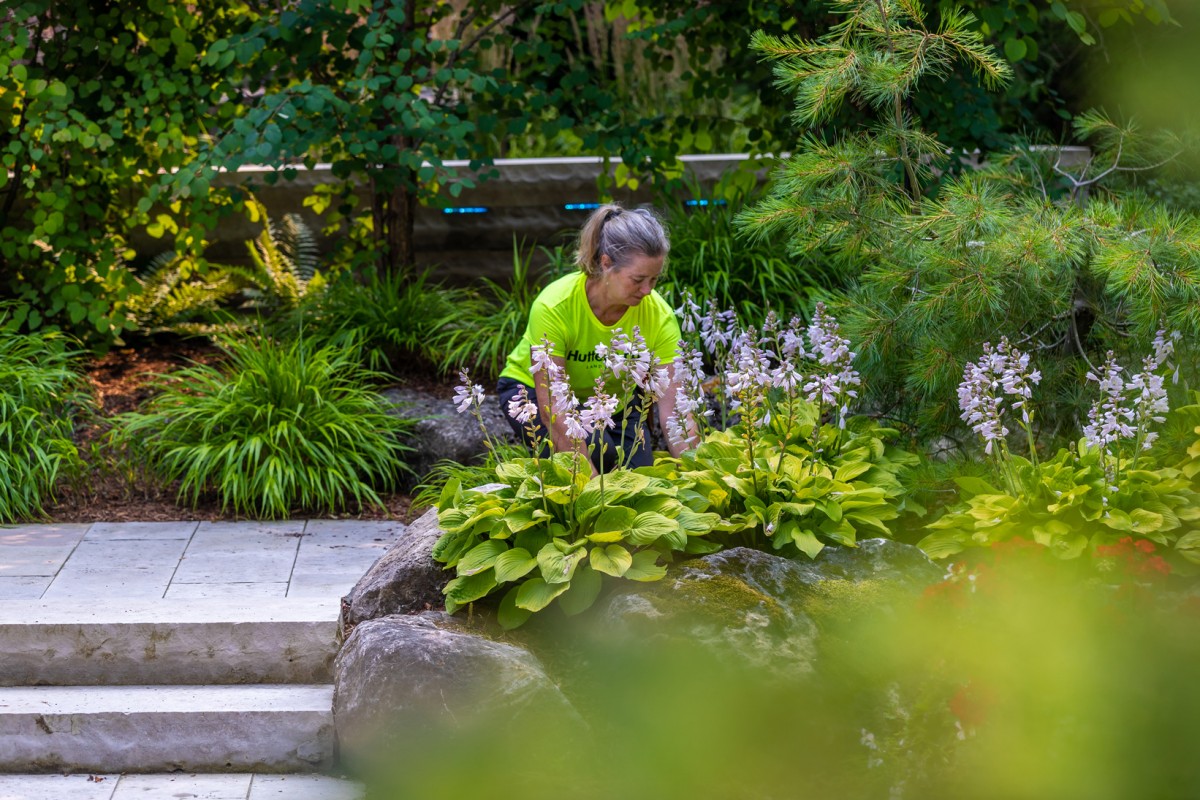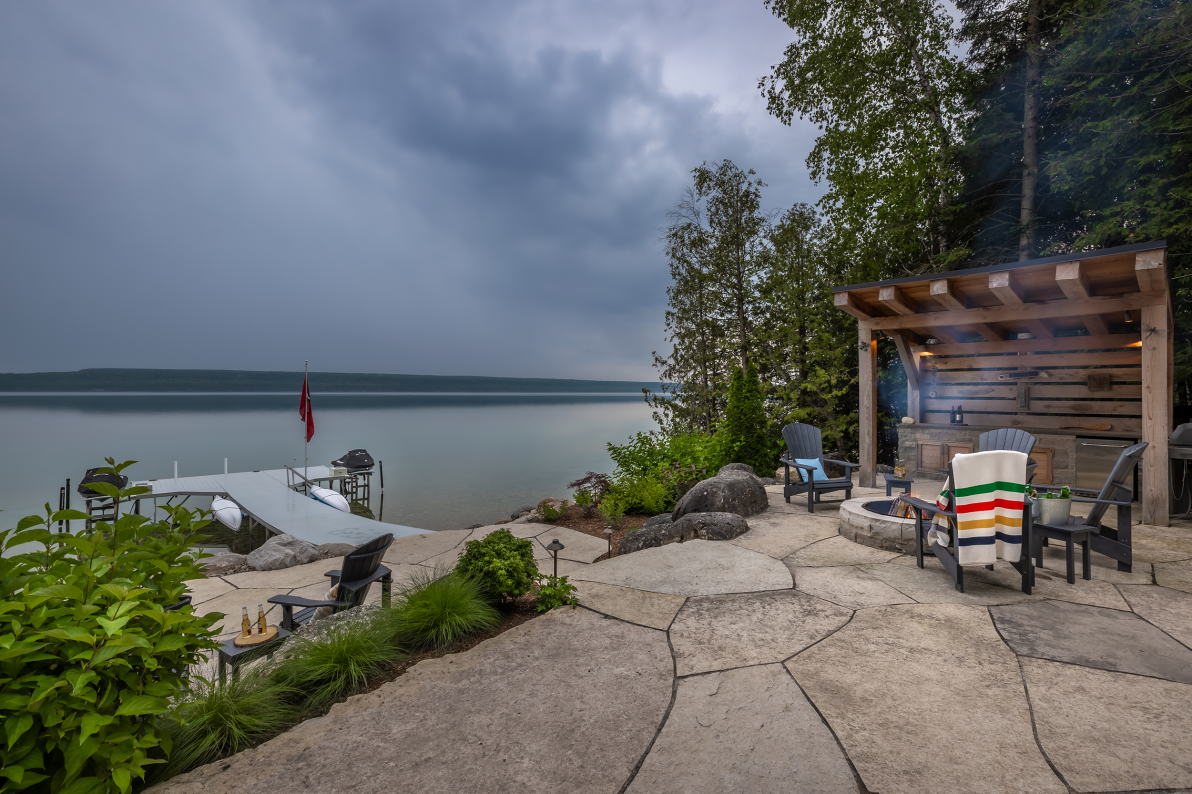Winters can be harsh up here along the shores of the great Georgian Bay. Before getting out the skidoo, make sure your property is fully prepared to handle the ice and snow.
It's easy to overlook your landscape as summer comes to an end. Our attention shifts to cozy nights by the fire and holiday preparations and we trade swimsuits for parkas. But before you settle in for winter, take a moment to explore these tips that will make preparing your property for the season easier. Let's begin!
Prepare your dock
We get some pretty harsh winter weather conditions up here in Grey and Bruce counties, so you need to make sure to protect your dock and get it ready for winter. Here are some key tasks that will keep it safe until next spring.
- Store dock accessories — Remove any accessories, such as chairs, tables, or decorative items, from the dock. Clean them thoroughly and store them in a dry place for the winter.
- Protect your dock from ice damage — If your dock stays in the water during winter, consider installing ice guards or bubblers. This keeps ice from forming around the pilings, protecting your dock from ice expansion and potential damage.
- Remove floating docks from the water — Floating docks should be taken out of the water and stored on land for the winter. If, for some reason, you can’t remove it, place a protective cover over it to shield it from snow, ice, and debris.
- Inspect your dock for damage — Carefully inspect your dock for signs of damage, such as loose boards, rot or rust. Repair or replace any damaged components to ensure the dock's structural integrity. If you have a metal dock, check the areas where the metal may be compromised or weakened, paying close attention to areas prone to corrosion, such as joints, welds and connections.
- Clean your dock — Give your dock a thorough cleaning by removing any dirt, debris, or algae that may have accumulated during the summer. Use a power washer or a scrub brush to clean the surface and remove any stubborn stains.
- Winterize accessories — Water-related accessories, such as hoses, pumps or fountains need to be drained and disconnected from the water supply. Store them in a frost-free location to prevent freezing and damage.
- Secure loose fastenings — Make sure bolts, screws and other fastenings on your dock are tight and secure. Loose connections make your dock prone to movement and potential damage during winter storms.
If you're unsure about any aspect of winterizing your dock, our dock service includes fall removals. If you prefer to DIY, It's always a good idea to consult with the manufacturer for any specific guidelines you need to follow.

Preparing your gardens for winter
Your favourite trees, plants and shrubs need a little preseason care if you want them to survive the cold winter months and emerge vigorous and healthy in the spring.
- Clean up the garden — Remove dead leaves, weeds and other debris from your flower garden. This will help to prevent disease and insect infestations and make it easier to plant new flowers in the spring.
- Prune and trim — Trim back any dead or damaged branches on your shrubs and trees, and prune most perennials back to about 2-3 inches above the ground (just don’t trim back hydrangea that relies on old wood for new growth). Trim back any overgrown or unruly plants to maintain their shape and prevent breakage from heavy snow or ice.
- Apply mulch — Apply a new layer of organic mulch around the base of your plants. This helps insulate the soil, retain moisture and protect the roots from freezing temperatures. Avoid piling mulch directly against plant stems to prevent rot.
- Protect tender plants — If you have delicate plants that are not cold-hardy, they’ll need protection from the elements. Use burlap, frost blankets or some other protective cover to shield them from freezing temperatures and harsh winds. This isn’t usually an issue if you plant native species since they’re adapted to our climate.
- Water before the ground freezes — Giving your plants a deep watering before the ground freezes helps them establish strong root systems and provides necessary moisture during winter. Don’t go overboard, though. Too much moisture can lead to root rot in cold temperatures.
- Clean and store garden tools — Remove soil or debris from your garden tools, sharpen blades, and apply a light coating of oil to prevent rust. That way they’re good to go in the spring.
The specific steps you take to winterize your garden can vary depending on the types of plants you have and the specific conditions you’re facing. It's always a good idea to consult with experienced gardeners for specific advice tailored to our region's climate. Our Green Thumb Package includes winter preparation.
- Add compost and/or fertilizer — Adding compost or fertilizer will give your plants the nutrients they need to grow strong and healthy throughout the summer.
- Add plantings — Perennials are a great low-maintenance choice for adding pops of colour to your garden — we can help you plan a great garden enhancement!

Prepare your irrigation system
If you have an irrigation system, there are a few things you should do each fall before the ground freezes. When shutting down your system, here are the general steps to follow.
- Turn off the water supply — This may sound like a no-brainer, but you’d be surprised at the number of people who forget this crucial step. Locate the main water shut-off valve for your irrigation system and turn it off to keep water out of the system during the winter months. Shut off the water to any outside faucets while you’re at it.
- Drain the system — To prevent water from freezing and bursting the pipes in your irrigation system it’s important to drain it. Open the drain valves on the backflow preventer, valves and any low points in the system and allow the water to completely drain out. When serving our clients’ irrigation systems, we use a blower to make sure no water remains.
- Remove Backflow Preventer and Filters — If you have a backflow preventer, take it off and store it inside for the winter. Remove and clean any filters in the system, ensuring they are free from debris.
If you’d like help winterizing your system, you can add irrigation maintenance to your Green Thumb Package and our technicians can take care of all that for you.
Fall lawn care
If you want a healthy and vibrant lawn next spring, you need to perform a few basic tasks to get it ready. If you want someone to help you with these chores, we can introduce you to a local service provider — lawn care is not something we do in-house.
- Aerate your lawn — Aerating your lawn allows water, air, and nutrients to penetrate the soil more easily, promoting healthy root growth. If you’re doing it yourself, make sure the machine you rent pulls plugs right out of the ground (core aeration) rather than just poking holes (spike aeration).
- Apply fertilizer — Test your soil to see if it’s missing any necessary nutrients. Using this information, choose the appropriate fertilizer and apply following the manufacturer's instructions. This gives your grass the nutrients it needs to emerge healthy and robust in the spring.
- Overseed your lawn — Fall is the best time to overseed your lawn because the cooler temperatures create optimal growing conditions, allowing new grass seeds to establish strong roots before the onset of winter. Choose a seed mix that is appropriate for your grass type and follow the manufacturer's instructions.
Give it a final mow and that’s it… you’re good to go!
Need a little help? Leave the hard work to us!
Winter preparations can be time-consuming, especially if this is a cottage or summer home. You can make it easier for yourself by signing up for our Green Thumb Package or inquire about our Dock Service Packages. Just give us a call to see how we can help!



